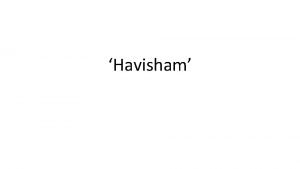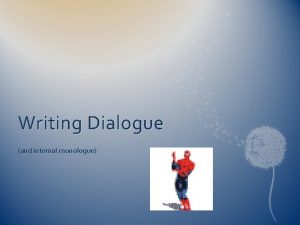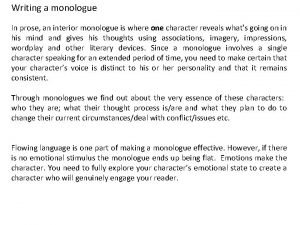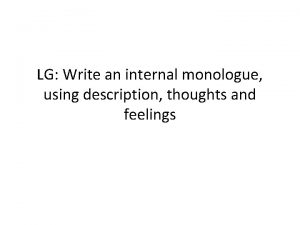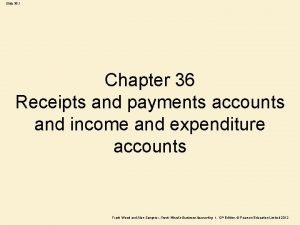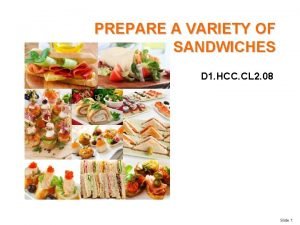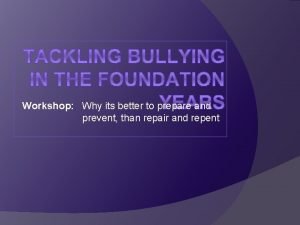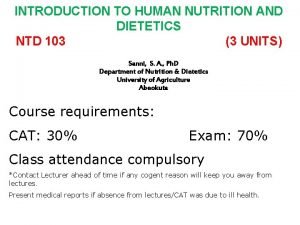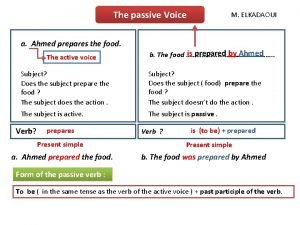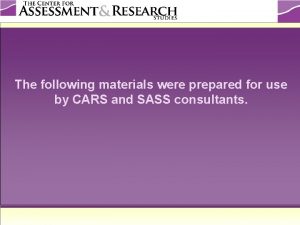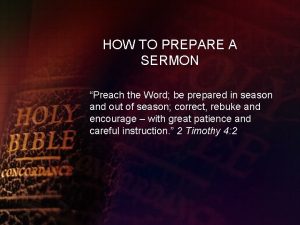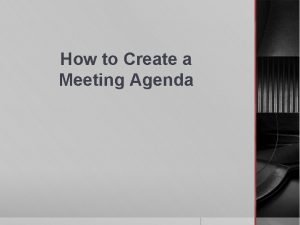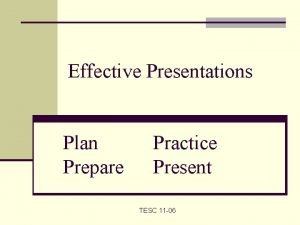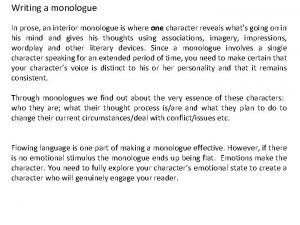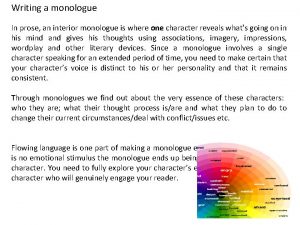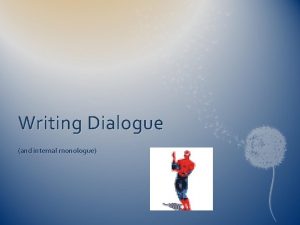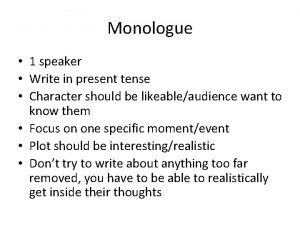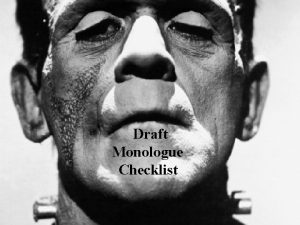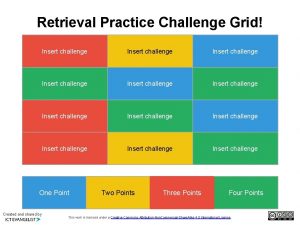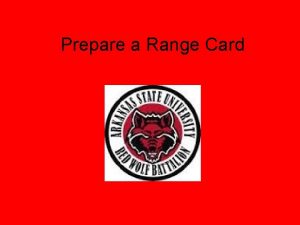Monologue Challenge Write and Prepare a Monologue What


























- Slides: 26

Monologue Challenge! Write and Prepare a Monologue

What is the Challenge? Throughout this task, you will: • Understand what a monologue is • Read and watch examples of a monologue • Write your own monologue using a photograph as a stimulus • Complete a character card for your character • Use the annotation key to annotate your monologue for performance, giving detail of which vocal techniques you would use in a live performance

What is a MONOLOGUE? § A MONOLOGUE is an extended speech spoken by one character, either in a direct address to the audience; or to another character/other characters onstage. § A MONOLOGUE reveals a character’s inner thoughts and feelings at a crucial or significant moment in the drama. § You will have seen monologues before in film and TV, let’s look at some examples…

Read and Watch Examples of Monologues § Here are 3 movie monologues… Also, if you can think of any other monologues from films/TV shows please let me know! Sharing is caring


Ferris Bueller’s Day Off § In this monologue we see the character Ferris Bueller, who is talking about the pointlessness of school and how he manages to fake illness to stay off. There is a comedic mood and atmosphere to the speech. § They bought it. Incredible! One of the worst performances of my career and they never doubted it for a second. How could I possibly be expected to handle school on a day like this? This is my ninth sick day this semester. It's getting pretty tough coming up with new illnesses. If I go for ten, I'm probably gonna have to barf up a lung, so I'd better make this one count. The key to faking out the parents is the clammy hands. It's a good non-specific symptom. I'm a big believer in it. A lot of people will tell you that a good phony fever is a dead lock, but, uh, you get a nervous mother, you could wind up in a doctor's office. That's worse than school. You fake a stomach cramp, and when you're bent over, moaning and wailing, you lick your palms. It's a little childish and stupid, but then, so is high school. § Life moves pretty fast. If you don't stop and look around once in awhile, you could miss it. I do have a test today, that wasn't bull-s--t. It's on European socialism. I mean really, what's the point. I'm not European. I don't plan on being European, so who gives a crap if they're socialists. They could be fascist anarchists and it still wouldn't change the fact that I don't own a car. (Singing in shower) It's not that I condone fascism or any 'ism' for that matter. Ism's, in my opinion, are not good. A person should not believe in an 'ism, ' he should believe in himself. I quote John Lennon: 'I don't believe in Beatles. I just believe in me. ' A good point there. After all, he was the walrus. I could be the walrus. I'd still have to bum rides off of people. § Watch the monologue here: § https: //www. youtube. com/watch? v=0 KFVLWX 7 e. EY&list=PLb. Eb 562 CLyk. EDl. B 41 pzqt. MMV h. Qm. Gbad 1 i&index=50


Katniss Everdeen – The Hunger games § In this monologue we see Katniss Everdeen filming a video with her fellow rebels. The point of the video is to inspire other people to join them in the fight against the evil president Snow and his government. There is a sense of passion and determination to overcome tyranny in this speech. § “I want to tell the rebels that I am alive. That I'm right here in District Eight, where the Capitol has just bombed a hospital full of unarmed men, women and children. There will be no survivors. " The shock I've been feeling begins to give way to fury. "I want to tell people that if you think for one second the Capitol will treat us fairly if there's a cease-fire, you're deluding yourself. Because you know who they are and what they do. " My hands go out automatically, as if to indicate the whole horror around me. "This is what they do and we must fight back!" "President Snow says he's sending a message. Well I have one for him. You can torture us and bomb and burn our districts to the ground, but do you see that? " One of the cameras follows where I point to the planes burning on the roof of a warehouse across from us. "Fire is catching!" I am shouting now, determined he will not miss a word of it, "And if we burn, you burn with us!” § https: //www. youtube. com/watch? v=z. TIVWEe. Mmzw


Billy Elliot § In this monologue we see working class boy Billy Elliot attend an audition with his dad to get into ballet school. He doesn’t have the technique but he has the love and the passion for dance. This really comes through in the monologue. The monologue is especially short but very powerful. § Tutor 1: What does it feel like when you're dancing? Billy: Don't know. Sorta feels good. Sorta stiff and that, but once I get going. . . then I like, forget everything. And. . . sorta disappear. Sorta disappear. Like I feel a change in my whole body. And I've got this fire in my body. I'm just there. Flyin' like a bird. Like electricity. Yeah, like electricity. § https: //www. youtube. com/watch? v=U 0 t. TT_87 Hh 8 § Here you can watch a reimagining of this monologue as a song, in the musical Billy Elliot: § https: //www. youtube. com/watch? v=f 0 IKFd. A__qg

Think about these 3 monologues from different genres. You could copy out and answer these questions to get you thinking more deeply about them. 1) What has happened before the monologue begins? 2) Who is speaking? 3) Who are they speaking to? 4) Where are they? 5) How do you know? 6) What is the mood of the monologue? 7) What type of personality does the character have? 8) What happens after the monologue ends? 9) What is the character wearing? What is your reason for this answer? *Remember there are NO wrong answers in Drama, only opinions. You will be able to find textual clues in the text/stage directions to help you to answer the questions, and if you can’t…use your imagination to fill in the gaps!

Writing your own monologue!

Writing your own monologue § Now let’s explore the stimuli you are going to use to write your monologue. The more deeply you think about your chosen stimulus the better quality your monologue will be! • A stimulus is the starting point for a drama- it’s the thing that gives you ideas. • A stimulus can be a picture, word, prop, sound etc.

1. §Who are they? §What did they do? §Are they being treated fairly? §Where are they? §What time is it? §What are they thinking?

2. § Who might have written this note? § What has happened? § Where are they? § What time is it? § How do they feel? § What are they thinking/what are they going to do?

3. §Who are they? §How do they know each other? §What has happened/is happening? §Where are they? §What time is it? §What is HE thinking? §What is SHE thinking?

Now it’s your turn to create a character and write a monologue based on one of the people in the photographs you have just been working on… § Choose one person from one stimulus that you can identify with in some way (This doesn’t mean they look like you!). They may be the same gender as you, they may remind you of someone you know, they may be in a situation that you can relate to. § Look at the information you have gathered about the people in the photographs. Now focus in more detail on the person you have chosen. § You will write out some detailed information about your imagined character and complete a character card before you start to write their monologue to give you a fuller idea of them.

Characterisation Work § Characterisation is the process of investigating and fully developing a character. It’s incredibly important in order to portray a character successfully. § It can build on role-play (imitating the character and behaviour of someone who is different from yourself) by adding individual physical and vocal characteristics, hence the Drama equation: § Characterisation = Voice + Movement § Further development can include the exploration of emotions, attitudes and motivation. § In characterisation, consideration should be given to the: • relationships with other characters in the drama • portrayal in terms of language, voice and movement • status, and changes in status, of the characters involved • social, economic and cultural background of the character

Character Card Template Character name: Age: Physical appearance: Describe what they look like and what they wear. Personality: Hobbies/interests: Relationships: Describe their relationship with friends, family and colleagues. Is it a strong relationship? Unhealthy? Voice: How does the character speak? E. g. stutters, quiet volume, timid tone. Movement: How does the character move? E. g. nervous body language, slouched posture, uncomfortable facial expression.

Writing a monologue! words (this will take approx. 3 minutes to perform) § Only one person speaking. (Someone else could say an opening line or be present onstage. ) § Significant information (climactic moment). E. g. the most tense and emotional moment § Revelation – disclose something: a secret or a worry perhaps. § 250

Annotating § To annotate means ‘to add notes to’ - thus providing more detail. § By annotating your script vocally you give yourself reminders of the vocal decisions you have made for your performance. § You will make decisions about: § Accent- Way of speaking used in a local area or country § Tone- Change of voice to express emotion (e. g. frustrated, calm…) § Volume- Loudness or quietness of the voice § Pitch- How high or low the voice is § Pace- Speed of speech (fast/slow) § Emphasis- The stress on a word or phrase § Pause- A break in speaking; period of silence

The Annotation Key Accent: write this at the top of your monologue / = short pause Word = fast pace (zigzag) Word = slow pace (wave) // = long pause Word = emphasis Tone: choose a colour that symbolises the emotion e. g. Angry Upset Envious Excited Word = high pitch Word = low pitch Volume: |||| shout ||| loud || quiet | stage whisper

An example of how to use the annotation key British RP || Thanks. / Sorry/ only the man over there won’t stop talking. / I wanted to read this in peace. I couldn’t concentrate. / ||| He just kept going on and on about collections or something. / || I normally don’t mind too much, only, if you get a letter like this, you need all your concentration. / / ||| You can’t have people talking in your ear – especially when you’re trying to decipher writing like this. Disappointed frustrated stern

Time to perform!

Submit your monologue! There are two ways to submit your monologue for this challenge. 1)Write out your monologue, with annotations. Perform it to yourself or someone in your house. Act out the character as realistically as possible. Try to show the emotions of the character using the voice notes you have put on the page. Take a clear picture of your written monologue with annotations and submit. 2)Learn and FILM yourself performing your monologue (you could get someone to record it for you or try to balance your phone on something and record yourself). Submit the monologue performance video. Submissions to be emailed to Miss Malcolm at jmalcolm@coltnesshigh. n-lanark. sch. uk

Good Luck! I look forward to seeing/hearing your monologues!
 Theatrical monologue
Theatrical monologue Teen challenge nottingham
Teen challenge nottingham Internal monologue writing examples
Internal monologue writing examples Monologue ideas to write
Monologue ideas to write Short monologues
Short monologues Prepare and produce cakes and pastries
Prepare and produce cakes and pastries Prepares frozen and cold desserts
Prepares frozen and cold desserts Selection of fruits and nuts for caramelized petit four
Selection of fruits and nuts for caramelized petit four Iupac name of chlorobutanol
Iupac name of chlorobutanol Dry gum and wet gum method
Dry gum and wet gum method Income statement for small business example
Income statement for small business example Method of preparation of effervescent granules
Method of preparation of effervescent granules Prepare and present sandwiches
Prepare and present sandwiches It is better to prepare and prevent
It is better to prepare and prevent Prepare and serve cocktails
Prepare and serve cocktails Flow chart of vitamins
Flow chart of vitamins Flow chart of vitamins
Flow chart of vitamins Power of media and information in economy
Power of media and information in economy Prepare thy work without
Prepare thy work without Chart of voice rules
Chart of voice rules Prepare the following materials
Prepare the following materials How to prepare scheme of work
How to prepare scheme of work Preparing guest clothes
Preparing guest clothes Naoh preparation
Naoh preparation How to prepare textual sermon
How to prepare textual sermon The agenda communicates important information such as
The agenda communicates important information such as Prepare practice present
Prepare practice present
